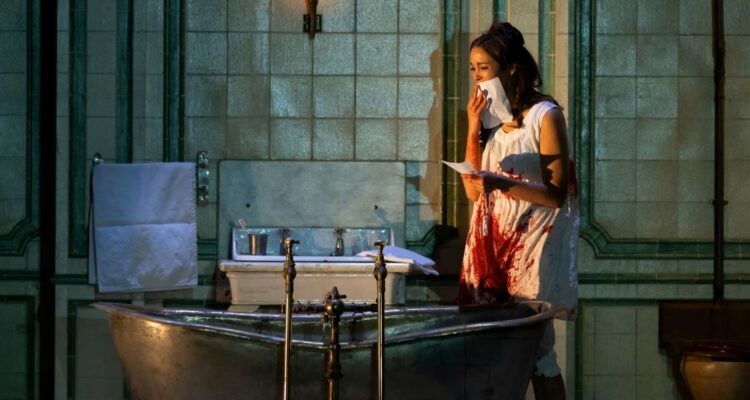Lucia is 46th of Donizetti’s 70 operas. Composed in six weeks when he badly needed success after his previous flop, Bianca e Faliero. It is the second most performed of Donizetti’s operas. It was Queen Victoria’s favourite opera. Its success depends on the brilliance of the soprano and tenor. In 1959 33-year-old Joan Sutherland made one of the most sensational debuts in the history of opera as Lucia. Sutherland with director Zefferelli introduced the blood-spattered dress for the first time. Previously a red sash symbolically represented blood.
Lucia falls in love with Edgardo, her brother Enrico’s enemy. Enrico needs Lucia’s political marriage to Arturo to save himself. She is tricked into the marriage. Edgardo returns, believing himself betrayed, he curses her. Lucia murders Arturo. The ‘mad scene’ follows, she dies at its conclusion. Edgardo, hearing the truth, kills himself.
This Marmite production, set in Donizetti’s time, has a feminist agenda, focussing on the female characters, Lucia and her confidante, Alisa. It explains Lucia’s actions, providing extra data whilst men are singing about her, using a split stage. For example, during Enrico’s first aria stage right, Lucia rifles through his wardrobe for a male disguise to meet Edgardo stage left. Two simultaneous scenes to watch exhilarate the dramatic tension.
My criticism, is that the ‘offstage’ action takes the eye away from the singers. Donizetti composed Lucia when the singer was supreme. Here the action dominates. During the murder one cannot focus on the singing during the busy action. Similarly, Enrico’s first aria and the Enrico/Edgardo duet, both thrilling, have busy distractions.
Lucia privacy is repeatedly invaded. She is trapped. Enrico even invades her bathroom. The chorus squeeze into tight spaces and are visually male for Lucia to feel more isolated and restricted in a male dominated world.
Katie Mitchell has fleshed out Lucia. Lucia is an intelligent, mature 30-something woman, on the shelf. Her life is dedicated to art and literature, never imaging love or children. Suddenly she is madly in love and pregnant. Having ‘lived’ life for such a short time, that life is suddenly brutally taken away.
The murder of Arturo is horrific. The excess ‘blood’ on her thighs implies she miscarried Edgardo’s baby. She is devastated. Her ‘mad scene’ begins. Lucia is partially sane, losing sanity in the cabaletta where she sees ghosts. In deep clinical depression, she slits her wrists in the bath. Edgardo rushes to the bathroom. Equally devastated, he slits his throat.
American soprano, Nadine Sierra has gone mad all over the world and is marvellous at it. She is a compelling actress with magical stage presence. Fresh from a stunning Met Juliette, her Lucia has everything. Wonderful coloratura, all the top Ebs, searing intensity, emotional vulnerability and beautiful long phrasing. Sierra’s ‘Regnava nel silenzio’ (The night, deep and dark), in Act I scene II, was received with rapturous applause, and the mad scene even more. The flute duet in the mad scene is stunningly accurate, and Sierra lets fly for the cabaletta when ‘madness’ descends and ghosts come thick and fast. We loved her ‘Elisir d’Amore’. We love this even more.
Xabier Anduaga, a 28-year-old Spanish tenor, hotly awaited debut, as Edgardo is superb. His expressive, bel canto artistry, with great breath control, long legato phrases, thrilling top notes, and even using head voice, is thrilling. He is a future star.
Polish baritone Artur Rucinski has taken up the reins left by the early retirement of his injured compatriot, Marius Kwiecen. His Enrico has unusual empathy – he is devastated by the tragic events. ‘Cruda, funesta smania’ in Act I shows a powerful, rich, warm voice. He holds the final note far longer than usual. Spectacular but who notices with the cross-dressing shown simultaneously on the left hand side of the stage?
Korean bass InSung Sing gives Raimondo a warm authoritative portrayal, with wonderful bass notes.
British mezzo Rachel Lloyd impresses as Alisa.
Lucia is all about bel canto singing. This A* cast delivers it, if you can ignore the over-busy stage action.
Royal Opera House, Covent Garden
Music by Gaetano Donizetti (1797-1898)
Libretto Salvadore Cammarano after Walter Scott’s novel The Bride of Lammermoor
Conducted by Giacomo Sagripanti
Directed by Katie Mitchell
First performance 26th December 1835 Teatro San Carlo Naples
Photo Credit
Cast includes Artur Ruciński, Nadine Sierra, Xabier Anduaga, Rachel Lloyd, Ingsung Sim, Andrés Presno.
Running time 3 hours 5 minutes with one interval
Performances until 18th May 2024

